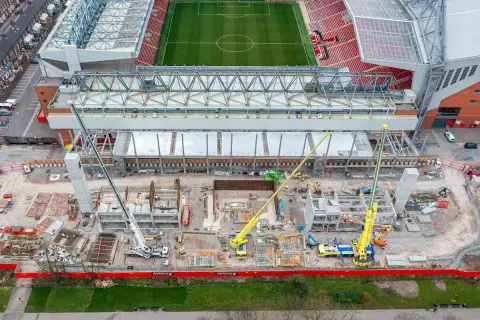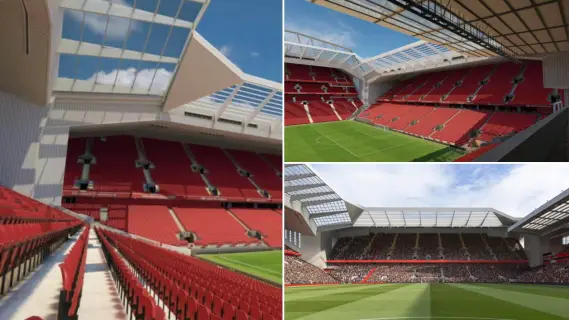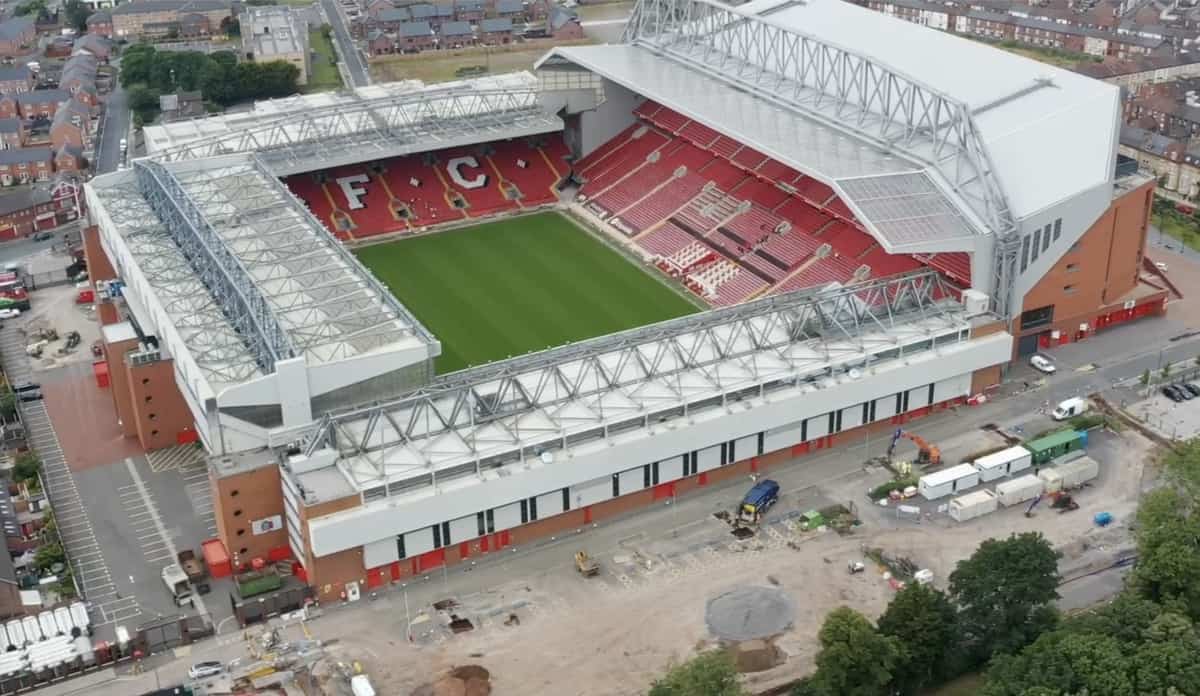Anfield is a football stadium that has been the home of Liverpool Football Club since its formation in 1892. Located in Anfield, Liverpool, England, the stadium was originally home to Everton Football Club from 1884 to 1891. This was before the latter moved to Goodison Park.
The stadium comprises four stands i.e., the Spion Kop Stand, the Main Stand, the Sir Kenny Dalglish Stand and the Anfield Road End Stand. The Anfield Road End Stand and Sir Kenny Dalglish Stand are two-tiered, while the Kop Stand is single-tiered. The Main Stand on the other hand is three-tiered.
In 2021 a project to expand and redevelop the Anfield Road End Stand began.
10 facts about the Anfield Road End Stand Project

1. Proposal for the project
The project was proposed back in 2010 following the abandonment of a plan to move the club to a new stadium in the adjacent Stanley Park. The plan was proposed back in 2002 and abandoned in 2010 by Fenway Sports Group, the clubs new. Fenway instead proposed a plan to expand Anfield Stadium in two phases.
The implementation of the first phase began in Dec 2014 with the extension of the Main Stand. This project led to the opening of one of the largest all-seater single stands in European football in Sep 2016. Subsequently, it increased the stadium capacity to the current 53,394 seats.
In May 2016 plans for the construction of a new 1,800 square meters club superstore were unveiled. The store would be situated on Walton Breck Road on the corner of the Kop and the new Main Stand. The actual construction began in Dec 2016 and the store opened to the public in the early 2017–18 season.
As part of the project, the space between the new store and the stadium was developed into a fan zone. The latter comprises new catering outlets and pre-match entertainment.
2. Approvals
Liverpool Football Club received initial outline planning permission for the redevelopment of the stadium back in 2014. According to this plan, the seating capacity of the stadium would be increased by 4,825, bringing the total capacity to 58,000.
Also Read: 10 facts about the proposed Etihad Stadium expansion project
In Aug 2019 the club revealed its intention to submit “ambitious new plans” for the Anfield Road End redevelopment. The new plan unlike the 2014s would increase the Anfield capacity to upwards of 60,000 at a total cost of £60 million.
After vigorous consultation with stakeholders, the club submitted the final planning application for the redevelopment in Dec 2020. June 2021 Liverpool City Council approved the plans.
3. Start of the project

Work on the Anfield Road End Stand officially commenced in Sep 2021. The first sod of the project was turned by Jürgen Norbert Klopp. The latter is a German professional football manager currently serving as the 21st full-time manager of Premier League club Liverpool.
4. Anfield Stadium Future Capacity
Following the completion of the Anfield Road Stand project, the stadium will become one of the largest in the Premier League with an overall capacity of over 61,000.
The Anfield Road Stand project will add 7,000 additional seats. These will include approximately 5,200 general admission seats and 1,800 sports bar lounge/hospitality facilities seats. Reportedly, this is the maximum achievable capacity in conformity with stadium design, safety and comfort standards.
5. Proposed Facilities
As part of the project, back-of-house facilities including a hospitality lounge will be developed. The Family Park will also be relocated to a covered position while the concourse will be improved. The concourse facilities will reportedly be in a similar style to the current facilities in the stadium’s Main Stand.
6. The “special atmosphere” at Anfield Stadium
Reportedly, retaining the special atmosphere at Anfield Stadium is one of the key design drivers and was instrumental in the decision to expand Anfield Stadium.
The lower tier of the project is therefore to be retained and refurbished while a new upper tier will be built above it. In addition, the four individual stands of the stadium will be retained in a bid to reflect its historical evolution.
However, there are plans to develop an acoustic and lighting strategy that meets with the clubs’ ambitions for a world-class Stadium.
7. Anfield Stadium to be an all-seater

As part of the expansion plans, Anfield will remain a fully seated Stadium. This will enable it to be capable of delivering different configurations of away fan seating, dependent on specific league or cup requirements as per the current Premier League clubs’ legislation.
8. Stadia accessibility for the disabled
The stadium will have dedicated accessible entrances for home and away fans. The entrances will be leading to new wheelchair tribunes with adjacent companion seats. Accessible seating will also be provided by approved design standards.
In addition, the new public realm will provide easy access from the disabled parking bays in Stanley Park to the Anfield Stadium. In total, 6 per cent of the parking spaces close to the Stadium will be provided for disabled supporters.
9. Completion of the Anfield Road End Stand project
The project was initially set for completion in the summer of 2022. However, owing to the delay in the submission of a planning application for the project, the completion date was moved to summer 2023 in time for the 2023–24 season. The delay was in light of the financial uncertainty caused by the COVID-19 pandemic.
The plan also included opening the stand in time for the first home game of the 32nd season of the Premier League and the 125th season of top-flight English football overall. With the start of the season only a few days away, the plan is not expected to go as intended. Anfield Road End Stand will not be fully open until October 2023.
10. Cost and the project team
The cost of the project jumped from the approximately 60 million pounds projected in the 2020 plan to about 80 million pounds.
The Anfield Road End Stand project’s main contractor is Buckingham Group Contracting Ltd.

